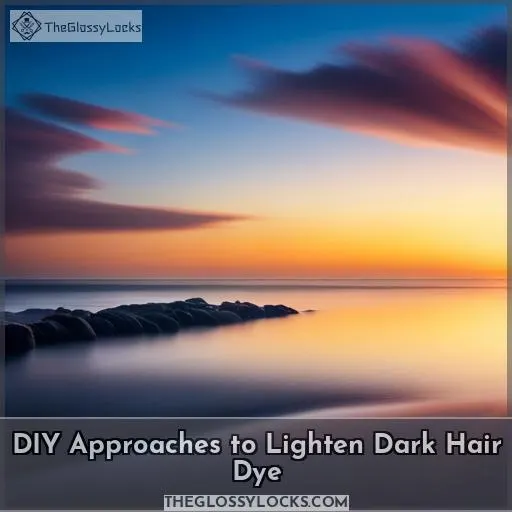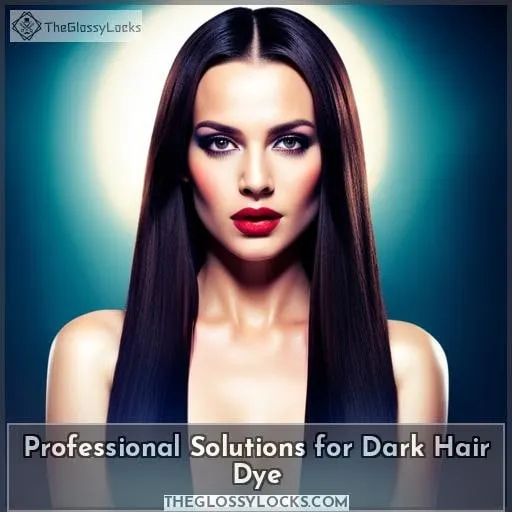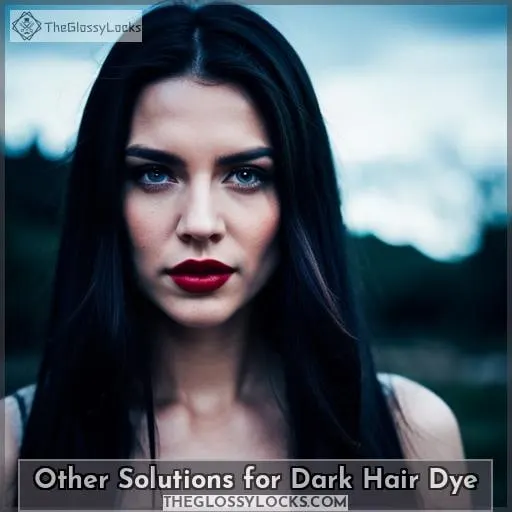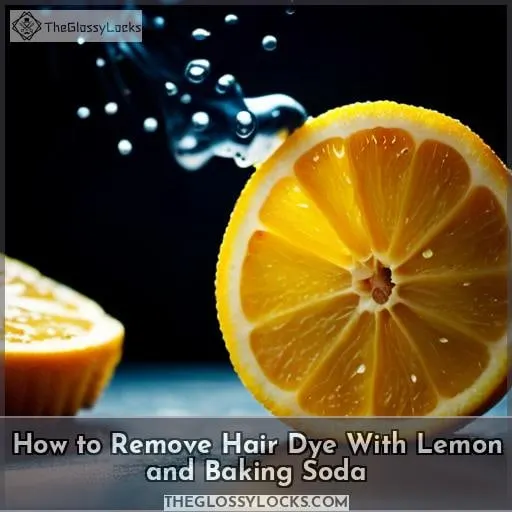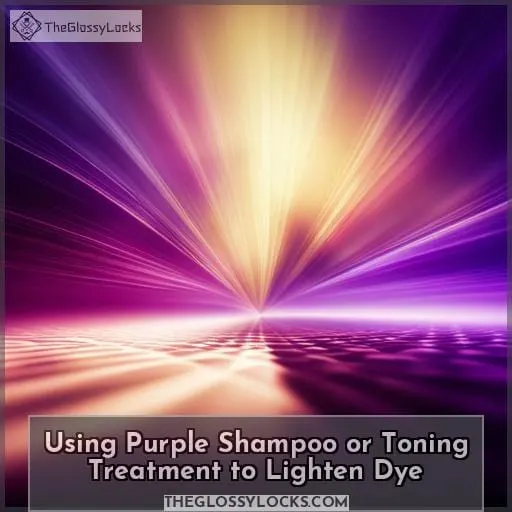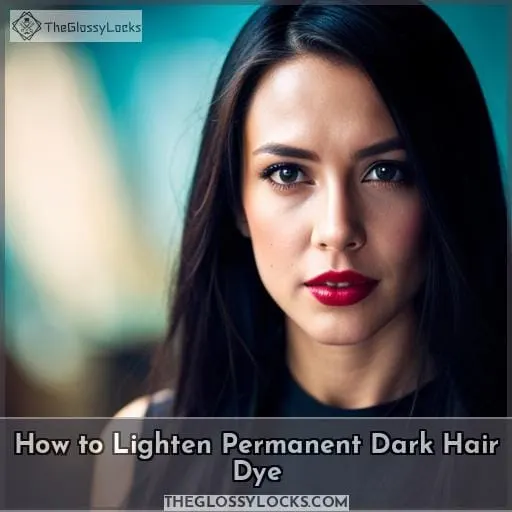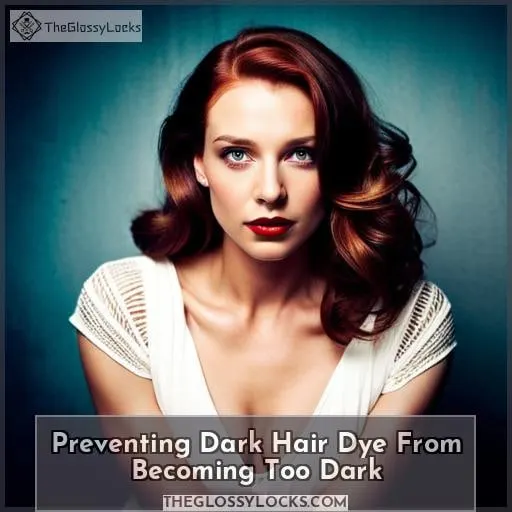This site is supported by our readers. We may earn a commission, at no cost to you, if you purchase through links.
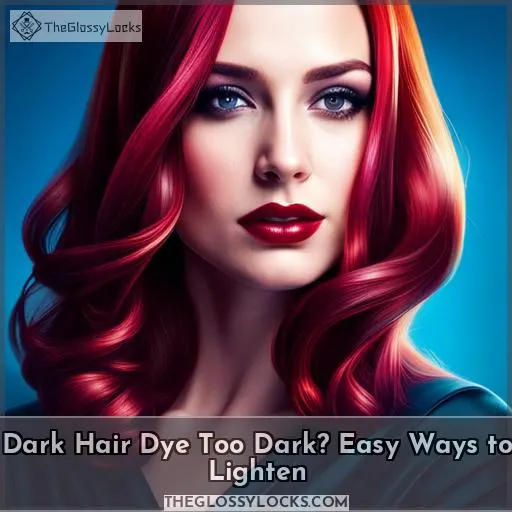 If you’ve tried to dye your hair at home but found the resulting color too dark for your liking, don’t despair! There are simple and effective ways to lighten up a darker-than-expected dye job. From DIY approaches like baking soda paste or vinegar rinses to professional solutions such as bleaching out the color or using a toner, there’s no need to live with hair that’s too dark for your taste.
If you’ve tried to dye your hair at home but found the resulting color too dark for your liking, don’t despair! There are simple and effective ways to lighten up a darker-than-expected dye job. From DIY approaches like baking soda paste or vinegar rinses to professional solutions such as bleaching out the color or using a toner, there’s no need to live with hair that’s too dark for your taste.
Table Of Contents
- Key Takeaways
- DIY Approaches to Lighten Dark Hair Dye
- Professional Solutions for Dark Hair Dye
- Other Solutions for Dark Hair Dye
- Post-Dye Treatments for Hair Health
- How to Remove Hair Dye With Lemon and Baking Soda
- Rinsing Hair With Apple Cider Vinegar to Lighten Dye
- Using Purple Shampoo or Toning Treatment to Lighten Dye
- How to Lighten Permanent Dark Hair Dye
- Preventing Dark Hair Dye From Becoming Too Dark
- Patience and Learning From Hair Dye Mistakes
- Conclusion
Key Takeaways
- DIY methods for lightening hair dye include using a baking soda and lemon paste mix, apple cider vinegar rinse, vitamin C tablets for color correction, and a lemon and baking soda mix for lightening.
- Hair care products for color adjustment include clarifying shampoo for removing excess color, purple/blue shampoo for brassiness, hair lighteners and toners, and color removers for gentle pigment removal.
- Professional solutions for dark hair dye include seeking help from stylists and considering a bleach bath for color removal.
- Post-dye treatments for hair health should be prioritized, and patience is key in the color correction process.
DIY Approaches to Lighten Dark Hair Dye
Are you looking for ways to lighten dark hair dye? There are several DIY approaches, such as baking soda and lemon paste, apple cider vinegar rinse, vitamin C tablets, clarifying shampoo, and purple/blue shampoo for brassiness.
These methods can help safely reduce the darkness of your dyed hair without completely removing all color.
Baking Soda and Lemon Paste
You can try a Sodashine Mix of baking soda and lemon paste to brighten up your locks quickly! This DIY method has several benefits, including lightening the hair color without harsh chemicals. When using this mix, there are precautions that must be taken, such as avoiding contact with eyes and skin.
To make the recipe, combine two tablespoons of baking soda with one tablespoon of lemon paste into a bowl until it forms a spreadable mixture. Lemon juice can also be used instead, but it will not have the same results as when using paste for maximum effectiveness.
Alternatives include honey or white vinegar in replacement for either ingredient if necessary.
Once applied to damp hair, let sit for 10-15 minutes before rinsing out thoroughly.
Apple Cider Vinegar Rinse
Soak up some cider-y goodness with an Apple Cider Vinegar Rinse for a quick and easy lightening of your locks! ACV is often used as a natural remedy for hair, providing many benefits such as softness, strength, and shine.
This vinegar rinse helps to dissolve product build-up in the hair that can prevent color from fading more quickly. To use this method, mix 1/3 cup apple cider vinegar with 4 cups of water in a spray bottle.
Spritz it onto dampened strands after shampooing or semi-permanent dye application. Leave it on for several minutes before rinsing thoroughly. Then, apply conditioner if desired.
Combining this rinse with other methods like clarifying shampoos can help achieve lighter results faster without using harsh chemical products.
Vitamin C Tablets
Take some Vitamin C tablets to help lighten your dark hair dye. Vitamin C tablets contain ascorbic acid, which can be used in a DIY method of color correction. When mixed with shampoo, it creates a mixture that helps lift the hair cuticles and gradually reduce the intensity of too-dark dyes over time.
It’s best to use this method after clarifying or bleaching if you’re looking for more dramatic results. However, it can still work on its own for milder toning needs. Patience is key with this method, as multiple washes may be needed before you notice any fading effects from using vitamin C tablets.
Clarifying Shampoo
Slather your locks in a clarifying shampoo to lightly remove the dark pigmentation. Perfect for post-dye treatment, its benefits include removing product buildup and excess oil.
A key difference between it and regular shampoo is frequency – use it no more than once or twice a month as overuse can dry out hair strands too much.
To get the best results, look for shampoos containing purifying agents like sulfates, salicylic acid, or tea tree oil. If you’re using dye with developer/bleach bath, then follow up with a moisturizing conditioner afterward to alleviate any damage caused by harsh chemicals in the mix.
Avoid unexpected pigmentation issues by understanding what ingredients work well together before applying them directly to your hair!
Purple/Blue Shampoo for Brassiness
Combat brassiness with a purple/blue shampoo to brighten your locks! This type of product helps neutralize tones and correct the color of any dye job gone wrong.
Here are some tips:
- Use it every few washes after bleaching or coloring hair for long-lasting results.
- Apply a generous amount on wet hair, let it sit for 3 minutes before rinsing off.
- Balance out this pigment restoration by using clarifying shampoos once a week.
- For damaged strands, use toners that have lower levels of ammonia and peroxide.
- Try deep conditioning treatments in between uses to restore moisture.
This helpful hue will keep blondes golden while correcting undesired shades. With proper maintenance, you can enjoy your desired look without risking further damage!
Professional Solutions for Dark Hair Dye
If your hair dye has come out too dark, there are professional solutions available to you. Bleeding out the color with a clarifying shampoo, using a hair lightener or toner to even it out, and applying color remover are all viable options.
If none of these DIY approaches work for you, then seeking help from a professional stylist is recommended.
Bleeding Out the Color
To lighten your hair, you can try bleeding out the color like a leaky faucet to achieve the desired results. A bleach bath or color remover is used to strip away the excess dye and restore balance. Clarifying shampoo helps too; it will naturally fade pigment from previous applications and help reduce brassiness for lighter tresses.
Hair health should be considered when using these methods, so keep in mind that excessive bleaching may dry out locks, requiring extra hydration afterwards.
Hair Lightener or Toner
Brighten up your hair with a lightener or toner that will help take the edge off any unwanted dark pigments. Hair lighteners are used to lift color from the hair, while toners work to neutralize brassy hues and add cooler tones.
Both require separate application techniques, so research tips on how best to use each for desired results.
When deciding on professional treatments, be sure to ask about moisturizing shampoos post-treatment as these will help keep locks looking luscious.
Color Remover
If you find that your hair dye is too dark, color remover can be a great option to help lighten it. Color Removers are designed to remove the artificial tint without causing damage or requiring harsh chemicals like bleach.
Benefits include allowing you to lift existing pigment from the hair shaft while still maintaining healthy-looking locks. The process involves mixing a powder with water according to directions on the package.
Safety should always come first when using these products. Make sure you have protective gloves and eye wear handy. Also, perform a patch test before application. Results vary depending on how long left in, but usually one session will reduce darkness by several shades.
If possible, opt for professional advice if unsure about what shade suits best. Alternatively, seek an expert’s opinion prior to a bleaching bath treatment at home.
Seeking Professional Help
If DIY fails, consider seeking the help of a professional stylist. Consulting professionals can provide salon options, such as hair color correction, and expert advice for the best results.
Professional assessment is necessary to determine which type of treatment will work best. This can range from consulting with a professional colorist to considering a bleach bath for your hair. Seeking professional help also provides specialized knowledge on how to care for your hair post-dyeing, ensuring a healthy look and feel in the long run.
Hair dye gone wrong requires precise procedures. Consulting with an experienced pro ensures that all steps are taken carefully, so you don’t end up damaging your tresses more than they already are! The proper procedure must be followed to get great-looking results.
- Consulting professionals
- Salon options
- Hair color correction
- Expert advice
- Professional assessment
- Professional colorist
Other Solutions for Dark Hair Dye
Sometimes, taking a step back and waiting for the dye to naturally fade is the best solution. In some cases, gentle post-dye treatments such as conditioners can help. A bleach bath may also be an option, but this should always be done with caution and care to prevent hair damage and unwanted pigmentation changes.
Vitamin C tablets or lemon juice can also lighten dark hair color while clarifying shampoo will gradually bleed out semi-permanent dyes over time. For brassiness issues, purple/blue shampoos are effective solutions that won’t strip away your natural color completely like bleach would do.
Instead, they give you subtle toning effects by counteracting yellow hues in your dyed strands without affecting the underlying pigment too much.
Professional approaches such as using a hair lightener or toner might give better results if DIY fails. It’s important to consult a stylist before resorting to more intensive fading methods, though they require patience rather than quick fixes when dealing with overly dark color applications on your tresses.
Finally, prioritize both safety measures and hair health at all times when choosing the right dye shades and approach it carefully. Rushing recoloring processes might lead to unexpected outcomes, which could take a longer time frame to fix afterwards.
Post-Dye Treatments for Hair Health
After you’ve corrected your hair color, ensure its health with post-dye treatments that nourish and moisturize. Start by using a deep conditioner to keep the moisture intact. To repair damaged cuticles from bleach or dye, opt for an oil treatment such as coconut or argan oil.
Additionally, use heat protection serum before flat ironing or blow-drying to prevent further damage. Consider doing a bleach bath every few weeks if needed. Take vitamin C tablets for lightening the ends.
Use a clarifying shampoo once in a while to remove product build-up. Purple and blue shampoos are a great way of neutralizing brassy tones.
For long-term maintenance, regular trimming is essential. Avoid using too many styling products like gels and sprays, as they can leave residue on strands over time, leading to breakage. A balanced diet is also important. Make sure you’re getting enough protein, vitamins, minerals, etc.
In addition, visit salons periodically so they can assess how healthy your hair really is. This will come in handy when planning future colors. Keep these tips close at hand while taking care of colored hair.
How to Remove Hair Dye With Lemon and Baking Soda
You can lighten dyed hair with a homemade concoction of lemon and baking soda. To make the mix, combine equal parts fresh lemon juice and baking soda in a bowl. Apply the mixture to your dry hair, making sure to saturate all strands evenly from roots to ends.
Leave it on for 10-15 minutes before rinsing out thoroughly with warm water followed by shampoo and conditioner as usual.
Use caution when mixing bleach bath for hair or any DIY lightening products as they have strong chemicals that could damage your scalp or cause irritation.
Natural fading is an option but may take weeks so plan accordingly if you don’t want drastic results right away.
Professional solutions like bleaching are ideal if mistakes were made while coloring since these methods remove even permanent dye quickly.
By using this simple technique alongside other methods like vitamin C tablets or apple cider vinegar tonic, you’ll be able to restore balance after color mishaps without compromising the health of your locks!
Rinsing Hair With Apple Cider Vinegar to Lighten Dye
Revitalize your hair with a Sidersplash Tonic of apple cider vinegar to erase that too-dark dye. Apple Cider Vinegar (ACV) is packed full of benefits, including helping to lighten dyed hair and restore the natural pH balance.
Prepare an ACV rinse by combining equal parts water and ACV in a spray bottle or bowl. Start with a weaker solution first to prevent over processing, and make it stronger if needed later on.
For best results, leave the mixture on for 15 minutes before rinsing off thoroughly with cool water. This will help set the color without drying out your locks! Using ACV requires minimal effort and no harsh chemicals, making it a safer option compared to methods like bleach baths or vitamin C tablets for lightening dark strands.
By using ACV, you can avoid damaging effects like split ends from bleaching processes. After rinsing off your DIY hair lightening treatment, don’t forget about aftercare. Use moisturizing masks once every two weeks, followed up by deep conditioning treatments regularly.
Using Purple Shampoo or Toning Treatment to Lighten Dye
To give your locks a lighter look, try using purple shampoo or toning treatments.
- It neutralizes yellow and orange tones in the hair.
- It helps prevent brassiness caused by lightening the hair too much.
- It adds shine to dull colored tresses.
- It prevents color fading.
Toning treatment tips:
- Use once a week for best results on dyed hair.
- Avoid over-toning as this can make colors appear muddy and unnatural looking.
- Apply heat when using toners for maximum effectiveness.
- Follow up with conditioner to keep strands hydrated.
Brassiness prevention is key when attempting to correct overly dark dye jobs. This includes avoiding direct exposure from sunlight, which can cause discoloration or oxidation of your hue after lightening attempts have been made.
Color correction techniques that are employed at salons should be done by professionals who know how much product works best for different types of haircuts/textures without damaging them further.
Lastly, maintain healthy hair habits after any sort of coloring process. Deep conditioning weekly will help restore moisture lost during bleaching/dyeing processes so you don’t end up with brittle strands down the line!
How to Lighten Permanent Dark Hair Dye
If your hair dye is too dark, don’t panic. There are several ways to lighten it up without having to start all over again. Color correction techniques like bleach or professional help from a stylist can help remove the unwanted pigmentation and give you back the color you were aiming for in the first place.
DIY remedies such as clarifying shampoo, baking soda/lemon paste mix, apple cider vinegar wash, and vitamin C tablets also come highly recommended by experts.
As for fading strategies like purple shampoos or toning treatments, it’s important to use them sparingly. They may not remove enough pigment depending on how much darker than desired your initial shade was meant to be.
Ultimately, when dealing with any type of hair mistakes, it’s crucial to maintain healthy habits before, during, and after coloring processes. Patience is key here! Respect timing instructions as well as settings while being mindful of staying close to natural shades rather than rushing into anything drastic.
Preventing Dark Hair Dye From Becoming Too Dark
By selecting the right shade of dye and taking preventative steps, you can ensure that your hair color turns out as intended. Start by understanding what level of dye will work best for your current hair hue.
Choose a few shades lighter than usual to reduce the risk of over-darkening when choosing permanent or semi-permanent color options.
Prior to application, use clarifying shampoo on wet hair. Then, follow with a deep conditioning treatment before applying the dye. This will create an even base tone that won’t absorb too much pigment from the applied product.
If further lightening is needed after the initial application, attempt a bleach bath for darker tones. However, this should be done cautiously as it strips away natural melanin. It is important to monitor the process properly afterwards with moisturizing treatments and/or toners, such as purple shampoo, for brassiness control maintenance practices thereafter.
Utilize these preventive measures along with proper care post-coloring sessions, including regular trims and deep conditionings. Avoid using shampoos designed specifically for colored treated tresses unless necessary.
This will help achieve the desired look without putting extra strain on delicate strands due to harsh chemicals or extreme heat styling techniques associated with corrective methods if the original outcome becomes unfavorable.
Patience and Learning From Hair Dye Mistakes
When it comes to dyeing your hair, learning from mistakes can be a difficult but essential part of the journey! Before taking on any new color correction project, conduct a patch test to ensure you won’t end up with an undesired shade.
If you do experience dark results from your dye job, take heart in knowing that there are many methods for lightening and correcting hair color without resorting to harsh remedies. Natural approaches such as baking soda and lemon paste or apple cider vinegar can help alleviate unwanted pigmentation until the desired hue is achieved.
Additionally, using purple/blue shampoo for brassiness will also aid in achieving lighter results while avoiding further damage caused by stronger chemical treatments like bleaching or toners.
Most importantly when dealing with DIY disasters is patience: give yourself time between lightening efforts so as not to overly stress the strands; respect timing and settings; try again only after giving proper rest periods—you don’t want permanent burns nor more over-processed locks!
With the right attitude towards coloring mishaps coupled with carefulness during all stages of the application process, one may emerge victorious over troublesome tresses!
Conclusion
No matter how careful you are in the hair dyeing process, sometimes mistakes are made. When your hair dye ends up too dark, there are a few options for lightening it. From DIY solutions like baking soda and lemon paste to professional treatments like bleaching and toning, there is something for everyone.
But whatever you do, make sure to prioritize your hair health above all. If you keep patient and take your time, you can lighten dark hair dye while keeping your hair looking and feeling great.

